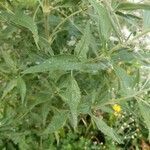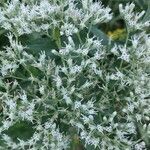Perennials, 50–150+ cm. Stems (from short caudices or stout rhizomes) single, sparsely branched distally, pubescent throughout (nodes sometimes with galls). Leaves usually opposite (nodes often appearing leafy, lateral buds producing 2+ pairs of leaves); sessile or subsessile; blades strongly 3-nerved from bases, lance-elliptic to oblanceolate, 50–120 × 5–20 mm, bases ± cuneate, margins entire proximally, serrate distally, apices acuminate, faces puberulent or villous, gland-dotted. Heads in corymbiform arrays. Phyllaries 8–10 in 2–3 series, oblong, 1–4 × 0.5–1.5 mm, (bases tapered) apices rounded to acute (not mucronate), abaxial faces pubescent throughout. Florets 5; corollas 3–3.5 mm. Cypselae 2–3 mm; pappi of 30–40 bristles 3.5–4 mm. 2n = 20, 30, 40.






